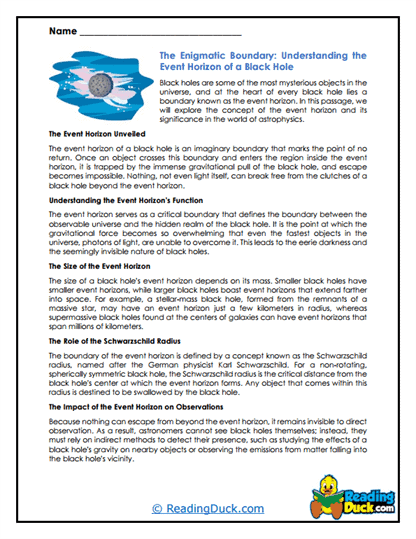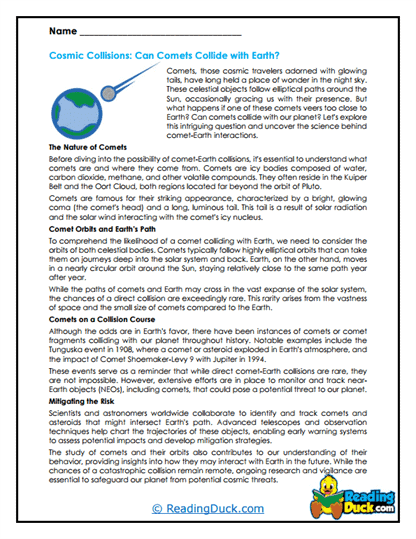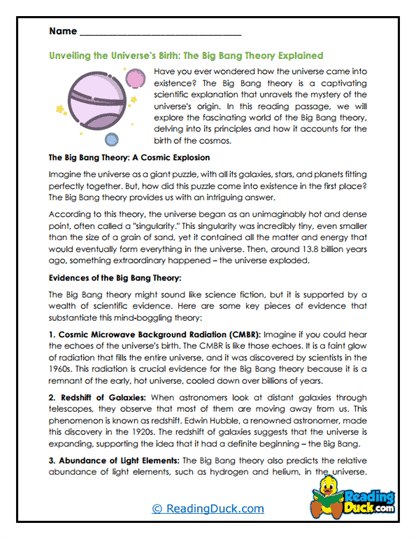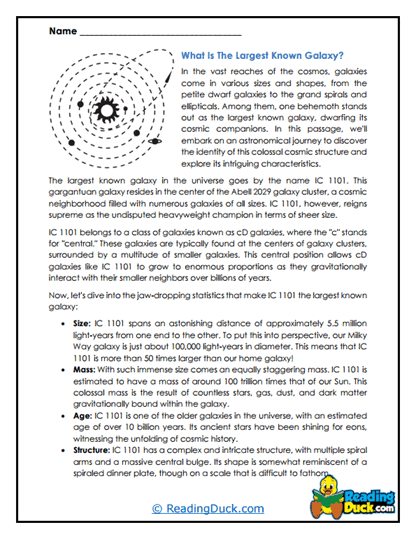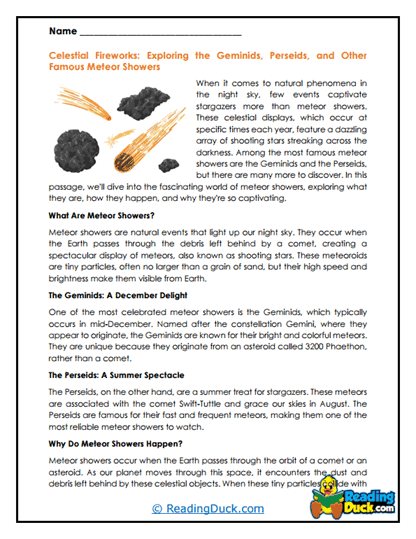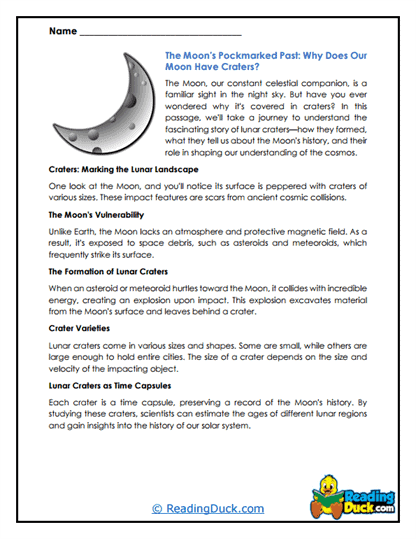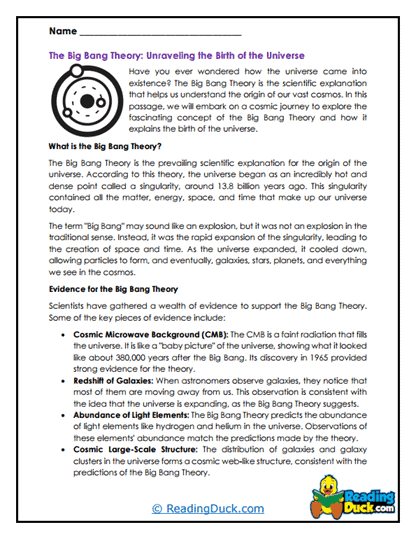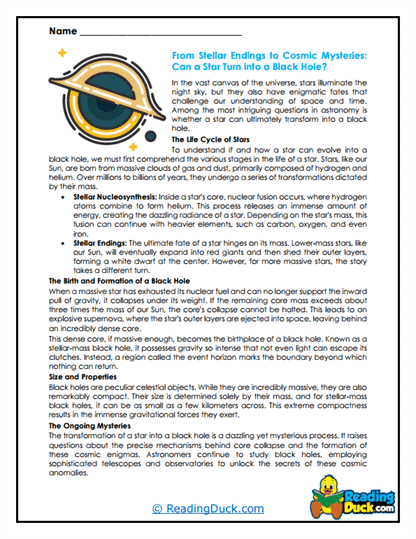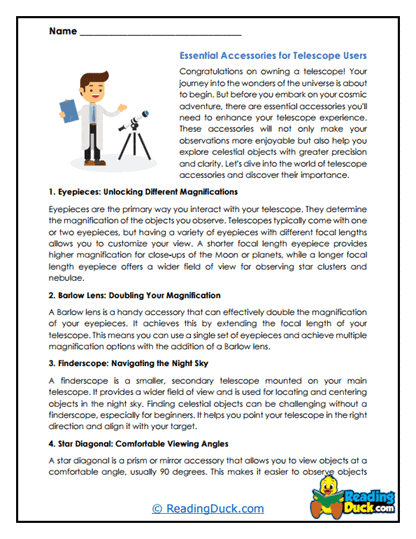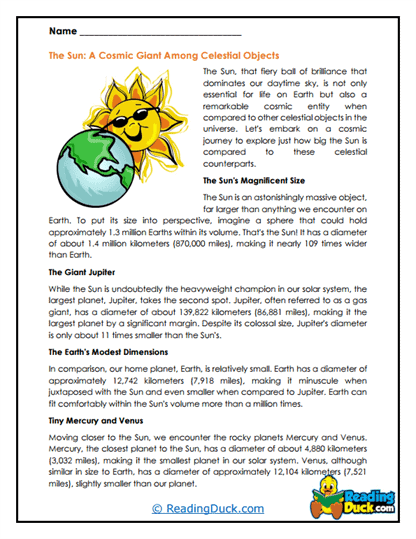Astronomy Worksheets
About Our Astronomy Worksheets
Our Astronomy worksheets provide an engaging and comprehensive exploration of the wonders of the universe. This collection is designed to captivate students’ curiosity about the cosmos, offering detailed insights into various astronomical phenomena and concepts. Through these worksheets, students can delve into the mysteries of space, from the formation of stars to the enigmatic nature of black holes, and gain a deeper understanding of the universe we inhabit.
This topic contains several sub-topics, each focusing on a specific aspect of astronomy. These sub-topics are further broken down into multiple worksheet sets, each designed to enhance students' comprehension and engagement through a variety of activities:
- Multiple Choice Questions: These questions assess students' understanding of the reading passages, focusing on key facts and concepts related to the topic. This format helps reinforce students' knowledge and encourages them to engage with the material in a structured manner.
- Short Answer Questions: This format challenges students to reflect on what they’ve learned by writing their responses in their own words. These questions promote deeper thinking and help students articulate their thoughts and insights about the astronomical concepts covered.
- Open-Ended Questions: These questions invite students to explore their personal responses to the material, encouraging them to express opinions, preferences, or interpretations related to the topics discussed. This format fosters critical thinking and allows students to connect with the content on a more personal level.
These activities help demonstrate students’ understanding of the material and enhance their connection to the subject matter. Each worksheet set includes an answer key, making it easy for educators to review and evaluate students' progress. All worksheets are available as PDF files, which can be easily viewed electronically, downloaded, and printed.
Exploring the Universe: An Introduction to Astronomy
Astronomy is the scientific study of celestial objects, space, and the universe as a whole. It is one of the oldest sciences, tracing back to ancient civilizations that looked to the stars to navigate, mark time, and understand their place in the world. Today, astronomy continues to be a field of exploration and discovery, providing insights into the origins of the universe, the nature of distant galaxies, and the fundamental forces that govern the cosmos.
Key Aspects of Astronomy:
- Black Holes: Black holes are among the most mysterious objects in the universe. These regions of space exhibit gravitational pulls so strong that nothing, not even light, can escape from them. Students will explore the formation of black holes, their effects on surrounding matter, and the ongoing research aimed at understanding these cosmic enigmas.
- Comets and Meteors: Comets are icy bodies that originate from the outer regions of the solar system and develop glowing tails as they approach the Sun. Meteors, on the other hand, are small rocky or metallic bodies that burn up upon entering Earth's atmosphere, creating the phenomenon known as "shooting stars." Understanding these objects helps students appreciate the dynamic nature of our solar system.
- Cosmology: Cosmology is the study of the universe as a whole, including its origins, evolution, and eventual fate. Students will learn about the Big Bang theory, the expansion of the universe, and the concept of dark matter and dark energy, which make up most of the universe's mass and energy.
- Galaxies: Galaxies are massive systems of stars, gas, dust, and dark matter, bound together by gravity. The Milky Way is just one of billions of galaxies in the universe. Students will explore the different types of galaxies, their structures, and the role they play in the larger cosmic framework.
- Moons: Moons, or natural satellites, orbit planets and come in various shapes, sizes, and compositions. Earth's Moon has a significant impact on life on our planet, influencing tides and stabilizing Earth's axial tilt. Other moons, like Jupiter's Europa, are of particular interest for their potential to harbor life.
- Outer Space: Outer space refers to the vast, seemingly empty regions beyond Earth's atmosphere. This sub-topic covers the vacuum of space, the challenges of space travel, and the concept of space as a frontier for human exploration and scientific discovery.
- Stars: Stars are massive, luminous spheres of plasma that generate energy through nuclear fusion. The Sun, our closest star, is the source of light and energy for life on Earth. Students will learn about the life cycle of stars, from their formation in stellar nurseries to their eventual demise as white dwarfs, neutron stars, or black holes.
- Telescopes: Telescopes are essential tools for astronomers, allowing them to observe distant celestial objects. From the early refracting telescopes used by Galileo to modern space telescopes like Hubble, students will explore the development of these instruments and their contributions to our understanding of the universe.
- The Sun: The Sun is the star at the center of our solar system and the primary source of energy for Earth. Students will learn about the Sun's structure, its role in supporting life, and the various phenomena associated with it, such as solar flares and sunspots.
These topics provide students with a comprehensive understanding of astronomy and its significance. By exploring these aspects, students can develop a curiosity and appreciation for the universe and the scientific methods used to study it.
Examples of Real-World Applications
Astronomy is not just a theoretical science; it has numerous real-world applications that affect our daily lives and our understanding of the universe. Here are some key examples:
- Navigation and GPS Technology: The principles of astronomy have been used for navigation for centuries. Today, satellite-based GPS systems rely on an understanding of orbital mechanics to provide accurate location data, essential for transportation, military operations, and even personal smartphones.
- Weather Prediction and Climate Studies: Observing solar activity, such as solar flares and sunspots, helps scientists predict space weather, which can impact Earth's climate and technological systems. Understanding these interactions is crucial for preparing for and mitigating the effects of solar storms.
- Space Exploration and Technology: Astronomy has driven advancements in technology, from the development of rockets and space probes to the creation of space-based observatories like the Hubble Space Telescope. These technologies have applications beyond astronomy, influencing fields such as telecommunications and materials science.
- Understanding Time: Astronomy has played a vital role in the development of accurate timekeeping. The study of Earth's rotation, the orbits of celestial bodies, and the observation of distant pulsars have all contributed to the precision of modern clocks and calendars.
- Inspiration for Innovation: The exploration of space and the study of distant worlds have inspired countless technological innovations, from improved imaging techniques to the development of new materials and processes. These innovations often have practical applications in industries such as healthcare, engineering, and manufacturing.
How to Integrate These Worksheets in a Learning Curriculum
To effectively incorporate our Astronomy worksheets into your curriculum, here are some tips for teachers and parents:
- Thematic Lessons: Organize lessons around specific astronomical themes or topics. For example, dedicate a week to studying the life cycles of stars, culminating in a discussion on black holes and supernovae.
- Cross-Disciplinary Connections: Link astronomy with other subjects such as physics, mathematics, and history. For instance, explore the mathematical equations that govern celestial mechanics or discuss the historical impact of astronomical discoveries on human civilization.
- Interactive Learning: Use multimedia resources like documentaries, planetarium software, or virtual reality experiences to complement the worksheets. This will help students visualize complex concepts and engage with the material in an interactive way.
- Creative Projects: Encourage students to create their own models of the solar system, design a poster explaining the phases of the Moon, or write a report on their favorite astronomical object. These projects allow students to apply their knowledge creatively.
- Group Discussions and Presentations: Use the open-ended questions in the worksheets to prompt group discussions or presentations. This will help students develop critical thinking skills and encourage them to express their ideas and interpretations.
- Field Trips and Observations: If possible, organize a visit to a local observatory or planetarium. Alternatively, conduct a night sky observation session where students can identify constellations, planets, and other celestial objects using telescopes or binoculars.
By integrating these strategies into your curriculum, you can help students develop a deeper understanding of astronomy, foster their curiosity about the universe, and enhance their scientific literacy. The Astronomy worksheets are a valuable resource that can be used in a variety of educational settings, making the study of the cosmos accessible and engaging for all students. Through consistent practice and exploration, students will not only learn about the wonders of the universe but also develop a lifelong appreciation for the science of astronomy.
